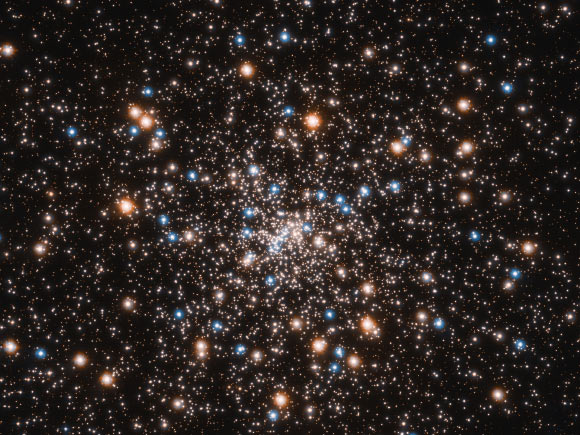Supermassive stars at the origin of globular clusters

A team from the universities of Geneva, Paris and Barcelona, with IEEC participation through the Institute of Cosmos Sciences (ICCUB), has found traces of supermassive stars that can explain the anomalies observed in large clusters of stars
The results, obtained thanks to observations by the James Webb space telescope, are published in the journal Astronomy and Astrophysics
Globular clusters are very dense groupings of stars distributed in a sphere, with a radius varying from a dozen to a hundred light years. They can contain up to 1 million stars and are found in all types of galaxies. Ours is home to about 180 of them. One of their great mysteries is the composition of their stars: why is it so varied? For instance, the proportion of oxygen, nitrogen, sodium and aluminium varies from one star to another. However, they were all born at the same time, within the same cloud of gas. Astrophysicists refer to this as ‘‘abundance anomalies’’.
A team from the University of Geneva (UNIGE), the Institute of Space Studies of Catalonia (IEEC — Institut d’Estudis Espacials de Catalunya) through its research unit the Institute of Cosmos Sciences of the University of Barcelona (ICCUB), and the Institut d’Astrophysique de Paris (CNRS and Sorbonne University) has made a new advance in the explanation of this phenomenon. The research has been published in the journal Astronomy and Astrophysics.
In 2018, the team had developed a theoretical model according to which supermassive stars would have ‘‘polluted’’ the original gas cloud during the formation of these clusters, enriching their stars with chemical elements in a heterogeneous manner. ‘‘Today, thanks to the data collected by the James Webb Space Telescope, we believe we have found a first clue of the presence of these extraordinary stars,’’ explains Corinne Charbonnel, full professor in the Department of Astronomy at the UNIGE Faculty of Science, and first author of the study.
These celestial monsters are 5 000 to 10 000 times more massive and five times hotter at their centre (75 million °C) than the Sun. But proving their existence is complex. ‘‘Globular clusters are between 10 and 13 billion years old, whereas the maximum lifespan of superstars is two million years. Therefore, they disappeared very early from the clusters that are currently observable. Only indirect traces remain,’’ explains Mark Gieles, ICREA professor and IEEC researcher at the ICCUB, who co-authors the study.
Thanks to the very powerful infrared vision of the James Webb telescope, the authors were able to support their hypothesis. The satellite captured the light emitted by one of the most distant and youngest galaxies known to date in our Universe. Located at about 13.3 billion light-years, GN-z11 is only a few tens of millions of years old. In astronomy, the analysis of the light spectrum of cosmic objects is a key element in determining their characteristics. Here, the light emitted by this galaxy has provided two valuable pieces of information: it has been established that it contains very high proportions of nitrogen and a very high density of stars.
This suggests that several globular clusters are forming in this galaxy and that they still harbour an active supermassive star, as the strong presence of nitrogen can only be explained by the combustion of hydrogen at extremely high temperatures, which only the core of supermassive stars can reach.
These new results strengthen the international team’s model, the only one currently capable of explaining the abundance anomalies in globular clusters. The next step for the scientists will be to test the validity of this model on other globular clusters forming in distant galaxies, using James Webb data.
Press release prepared in collaboration with the Institute of Cosmos Sciences (ICCUB) and the University of Geneva.
Main Image
Caption: The globular cluster M13, 22 000 light years from Earth, consisting of a million stars squeezed into a space 150 light years across.
Credits: HST / STScI / NASA / ESA
Links
– IEEC
– ICCUB
– James Webb telescope
– University of Geneva
– Institut d’Astrophysique de Paris
More information
This research is presented in a paper entitled “N-enhancement in GN-z11: First evidence for supermassive stars nucleosynthesis in proto-globular clusters-like conditions at high redshift?”, by C. Charbonnel et al., which appeared in the journal Astronomy and Astrophysics on 5 May 2023.
The Institute of Space Studies of Catalonia (IEEC — Institut d’Estudis Espacials de Catalunya) promotes and coordinates space research and technology development in Catalonia for the benefit of society. IEEC fosters collaborations both locally and worldwide and is an efficient agent of knowledge, innovation and technology transfer. As a result of more than 25 years of high-quality research, done in collaboration with major international organisations, IEEC ranks among the best international research centres, focusing on areas such as: astrophysics, cosmology, planetary science, and Earth Observation. IEEC’s engineering division develops instrumentation for ground- and space-based projects, and has extensive experience in working with private or public organisations from the aerospace and other innovation sectors.
IEEC is a private non-profit foundation, governed by a Board of Trustees composed of Generalitat de Catalunya and four other institutions that each have a research unit, which together constitute the core of IEEC R&D activity: the Universitat de Barcelona (UB) with the research unit ICCUB — Institute of Cosmos Sciences; the Universitat Autònoma de Barcelona (UAB) with the research unit CERES — Center of Space Studies and Research; the Universitat Politècnica de Catalunya · BarcelonaTech (UPC) with the research unit CTE — Research Group in Space Sciences and Technologies; the Spanish Research Council (CSIC) with the research unit ICE — Institute of Space Sciences. The IEEC is a CERCA (Centres de Recerca de Catalunya) centre.
Contacts
IEEC Communication Office
Barcelona, Spain
E-mail: comunicacio@ieec.cat
Lead Researcher at IEEC
Barcelona, Spain
Mark Gieles
Institute of Space Studies of Catalonia (IEEC)
Institute of Cosmos Sciences (ICCUB)
E-mail: mgieles@ieec.cat
